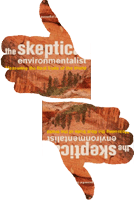In The Skeptical Environmentalist, Bjorn Lomborg writes that “basically, the world’s forests are not under threat.” A charitable reader could attribute this flawed conclusion to errors of omission and ignorance; perhaps the author simply doesn’t know the sources well enough to interpret them properly. Less charitably, one might reasonably conclude that Lomborg intentionally selects his data and citations to distort or even reverse the truth. His interpretations of data on global forest cover and Indonesian forest fires aptly illustrate both failings.
Lomborg scorns an analysis by the World Wildlife Fund that found that nearly two-thirds of the world’s original forests, dating to the pre-agricultural period (defined as 6000 BC), have at one time been cut. He challenges it by stating that, “Most sources estimate about 20 percent.” Whatever the merits of WWF’s claim, Lomborg confusingly contrasts net loss of forest cover (that is, his figure of loss of natural forest offset by regrowth and new plantations) with loss of original forest (WWF’s figure).
Moreover, the sources Lomborg cites in the relevant footnote do not support his claim. The first, a 1993 college textbook by Andrew Goudie, indeed gives a figure of 20 percent net loss in forest cover since pre-agricultural times. However, its author provides no reference or authority for this number. The second source, by Michael Williams, is stated in the footnote as giving the (amazingly) low figure of 7.5 percent loss, but a review of the source itself reveals that Lomborg has misread 7.5 million square kilometers as though it were a percentage.
The last two sources mentioned in the footnote, which give figures of 19 and 20 percent, do not purport to measure forest loss during the entire 8,000-year period for which Lomborg cites them. On the contrary, these two sources cover only tiny fractions of the relevant time period — less than 4 percent (300 years) and 2 percent (140 years), respectively — and even so, each registers roughly a 20 percent loss of forest.
Barking Up the Wrong Tree
Another claim by Lomborg — that global forest cover has remained remarkably stable over the past 50 years — is based on two acts of statistical conjuring. First, he expresses changes in forest cover as a percentage of the total land area of the world, a technique that reduces changes of millions of hectares to fractions of 1 percent. Second, he cobbles together a variety of different data sources compiled using different definitions of forest and different methodologies. These different data sets cannot be strung together to form a consistent time series. The United Nation’s Food and Agriculture Organization, the “official source” on which Lomborg proudly claims to rely, does not attempt to construct such a time series. Yet the first graph in Lomborg’s chapter on forests prominently features an FAO data series of forest cover that was generated for agricultural purposes and discontinued by FAO precisely because it considered the data unreliable for assessing forests.

Treed off.
Photo: Art Wolfe, Inc.
FAO forestry data can be difficult to understand, as Lomborg’s notes make amusingly clear. In Note 767, he defines closed forest as 20 percent of forest cover rather than forest where the tree canopy covers 20 percent or more of the ground. More seriously, he appears to believe that the U.N. carried out two global forest surveys in 1995 and 1997. In fact, the U.N. surveys forests only once per decade. The 1990 survey was updated with a mathematical model to the year 1995 and these results were published in the 1997 State of the Forest report.
Are the world’s forest “basically not under threat” as Lomborg claims? Lomborg quotes the FAO’s most recent survey, the Forest Resources Assessment 2000 (FRA 2000), which states that tropical forests are being deforested at an annual rate of 0.46 percent. Lomborg claims this figure is “much below the feared 1.5-4.6 percent” rate, although he provides no clue as to who feared such extraordinary rates. But there is a serious error here: Lomborg is quoting the FAO’s figure for tropical deforestation as a percentage of global forest cover, not as a percentage of tropical forest cover. The vast majority of forest clearance is occurring in the tropics — forest area is actually expanding in most of the temperate zone — so this error grossly distorts the rate of tropical deforestation.
According to the 2000 report, about 161 million hectares of natural forest were lost during the 1990s, of which 152 million hectares (about 94 percent) were in the tropical world. The 2000 report puts total global forest cover at about 3.9 billion hectares, 95 percent of which is “natural forest,” meaning that there are about 3.7 billion hectares of natural forest. Of this, 47 percent, or 1.74 billion hectares, is in the tropics. Thus if 152 million hectares of natural tropical forests were lost during the 1990s, from a total natural tropical forest area of 1.74 billion hectares, then tropical forests shrank by 8.7 percent over the decade — an annual average rate of 0.87 percent.
In the Line of Fire
Lomborg devotes an entire page to Indonesia’s fires of 1997-1998, acknowledging that they were serious but also claiming that they were not out of the ordinary. He criticizes WWF for estimating that 2 million hectares burned and contrasts this claim with the “official Indonesian estimate” of 165,000-219,000 hectares. He notes that the WWF estimate included both forest and non-forestland, but does not point out that the official Indonesian estimate he quotes was for forestland only. He then claims, citing a 1999 United Nations Environment Programme report, that subsequent “satellite-aided counting” indicated that upwards of 1.3 million hectares of forest and timberlands may have burned.

The official Indonesian estimate of 520,000 burned hectares of forest and non-forest land was based on reports by plantation owners — who were responsible for much of the deliberate fire-setting and had no incentive to report accurately. This estimate was quickly challenged by the German-supported Integrated Forest Fires Management Project, which, using satellite data and ground checks, produced convincing evidence that fires had actually burned some 5.2 million hectares in 1998 alone — 10 times the Indonesian government’s estimate. Informed of this data gap, the Indonesian Ministry of Forestry and Estate Crops effectively instructed the governor of East Kalimantan (the province that suffered the worst fires) not to allow the new data to be made public, citing the need “to protect national stability.” Despite strong official protests from the German government, the Indonesians never retracted their original estimate or made the new data public.
Regarding estimates of how much forest actually burned, Lomborg cites a UNEP report, which in turn refers to an analysis, “A Study of the 1997 Fires in Southeast Asia Using SPOT Quicklook Mosaics,” that was based on 766 satellite images. These images covered the islands of Kalimantan and Sumatra only, for just August to December 1997. The study did not examine burn areas for 1998, nor did it take into account fires on other islands. The UNEP report states that this estimate represents “only a lower limit estimate of the area burned,” although Lomborg’s readers are not so informed.
An analysis by the Singapore Centre of Remote Imaging, Sensing, and Processing using the same satellite images yielded a total burn area estimate for 1997 and 1998 of nearly 8 million hectares. In 1999, a technical team funded by the Asian Development Bank and working through the Indones
ian National Development Planning Agency aggregated and analyzed all available data sources and estimated that the area burned during 1997-1998 totaled more than 9.7 million hectares, of which some 4.6 million hectares were forest.
Thus, the most authoritative consensus estimate of the extent of forests burned during the Indonesian fires of 1997-1998 is more than twice the WWF estimate that is derided by Lomborg.
Lomborg’s interpretation of global forest cover and Indonesian forest fires are just two examples of the incomplete and superficial analyses that underpin too much of this book. In his introduction, the statistician tells us that his skills lie in “knowing how to handle international statistics.” A few paragraphs later, he confesses that, “I am not myself an expert as regards environmental problems.” Unfortunately, statistical prowess by itself does not guarantee accuracy, insight, or understanding. A little more expert knowledge would have significantly diluted this book’s glib optimism. Indeed, the book would probably never have been written.



